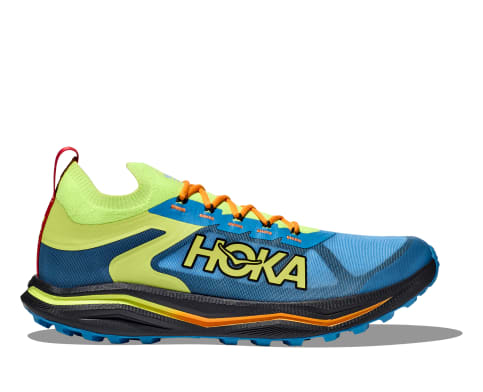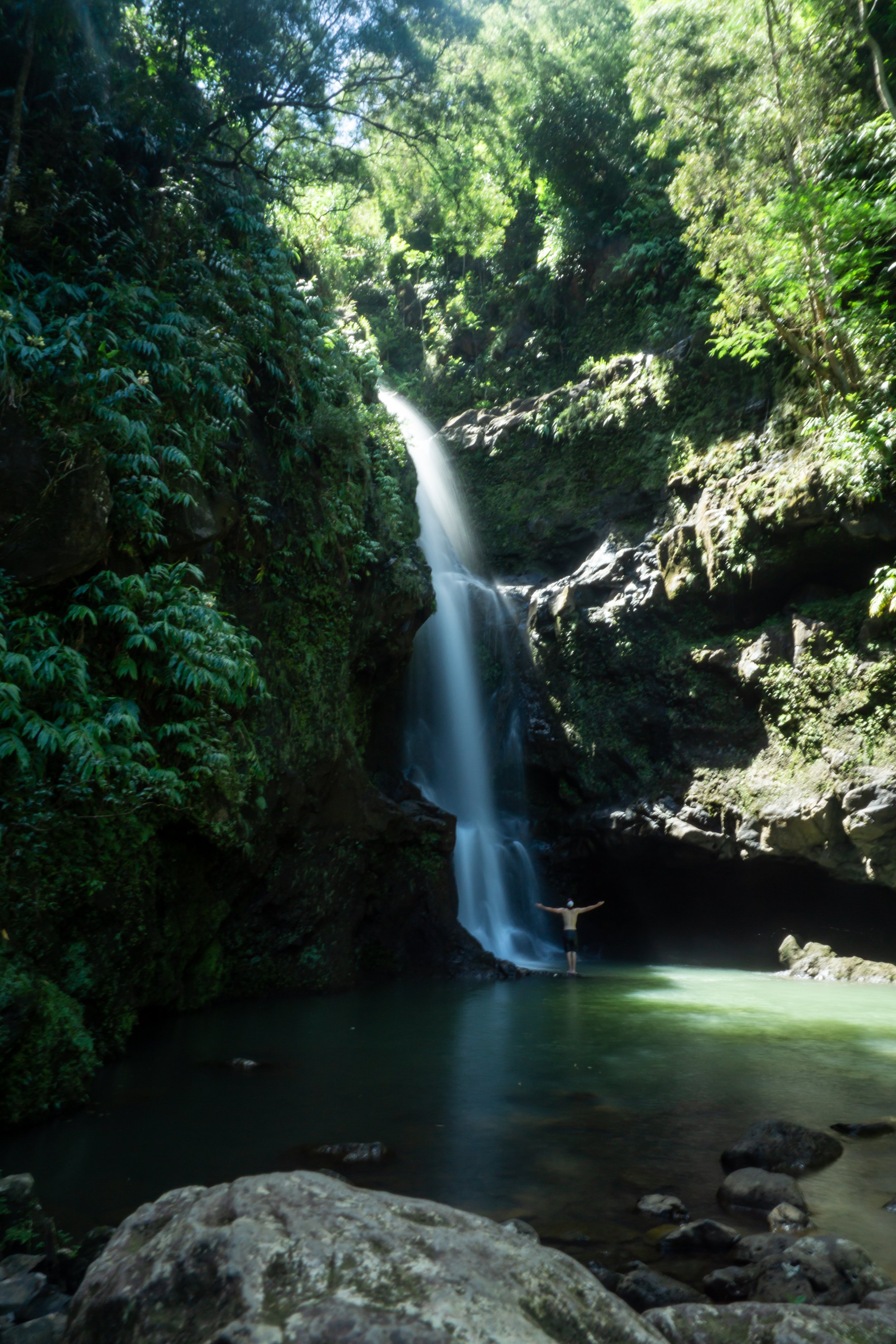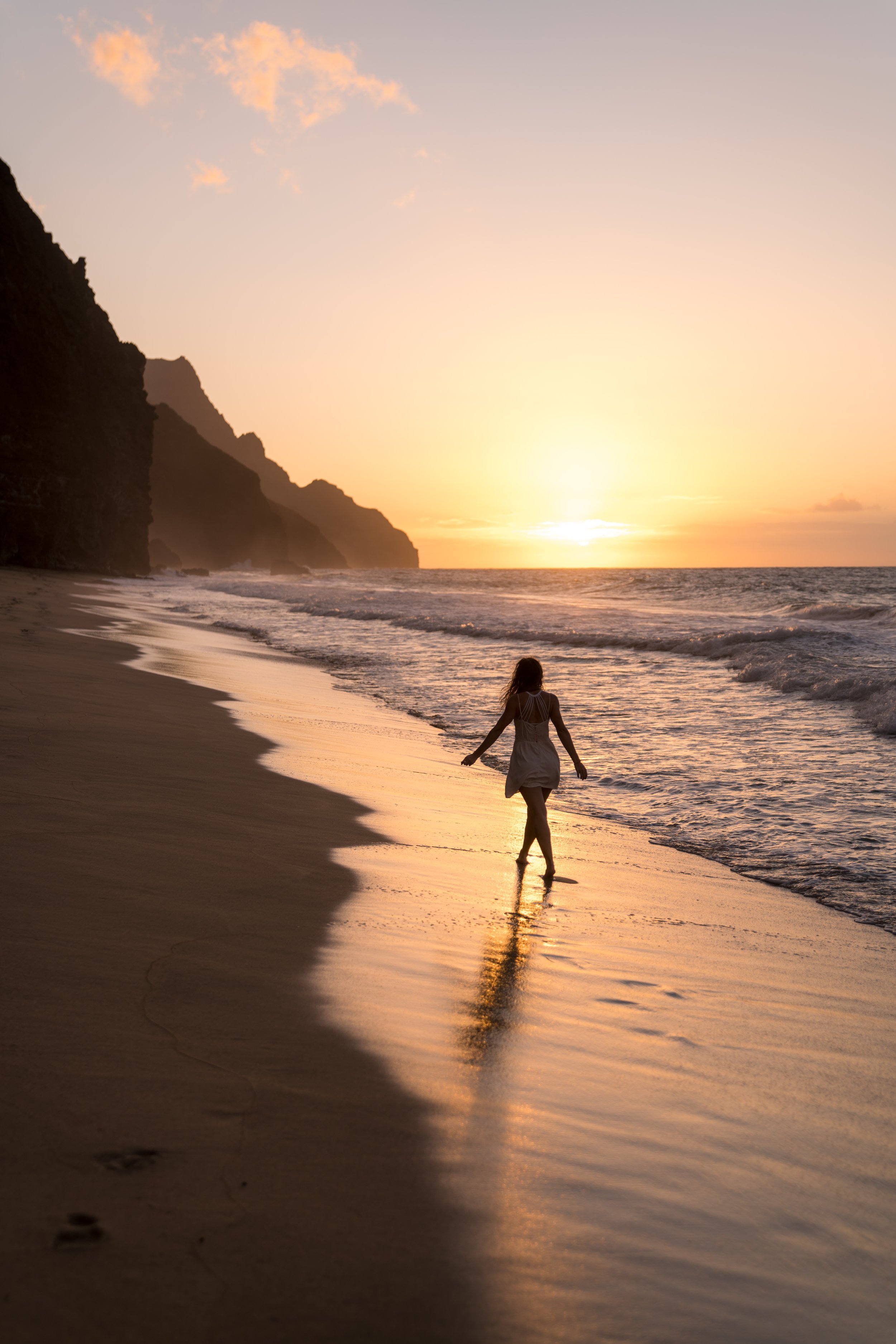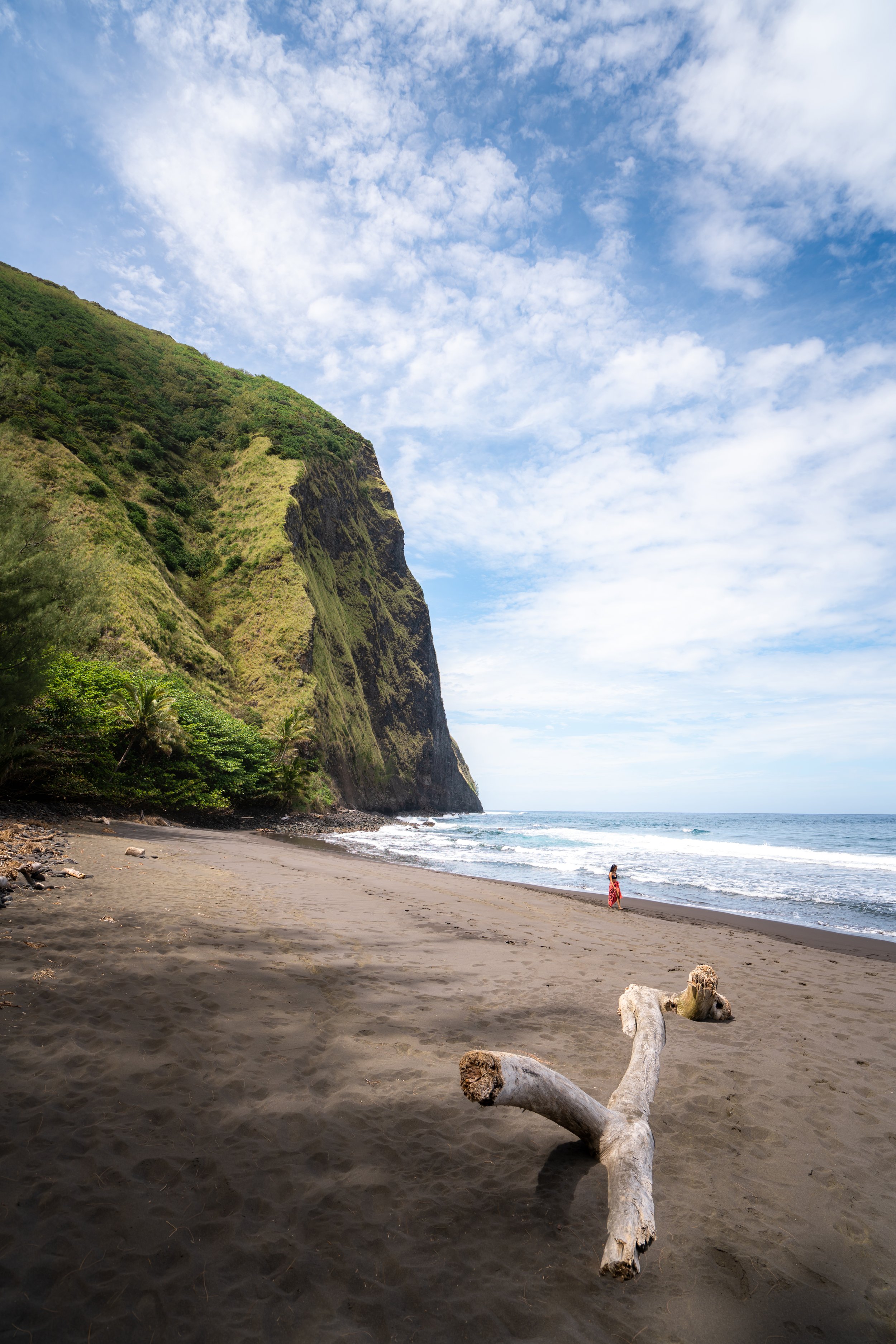Hiking the Puʻu Pehe Trail (Sweetheart Rock) on Lānaʻi, Hawaiʻi
Distance: 0.9 miles / 1.4 km
The Puʻu Pehe Trail, more commonly known as the Sweetheart Rock Trail, is an iconic Lānaʻi day hike and a favorite among both locals and visitors alike—especially at sunset!
Beginning at Hulopoʻe Beach on the South Shore of Lānaʻi, the hike up to Sweetheart Rock in Mānele is almost always known for it’s beautiful, sunny weather. This is why I recommend hiking Puʻu Pehe if the weather for other hikes on the island—such as the Koloiki Ridge Trail or the Hiʻi Trail near Lānaʻi City—isn’t looking as good.
In any case, I think the photo below speaks for itself! This is why, if you have the flexibility to hike to Sweetheart Rock at any time of day, choose sunset—you won’t be disappointed!
Puʻu Pehe Trailhead Parking
Parking for the Sweetheart Rock Trail is located at Hulopoʻe Beach Park, which is open to the public, regardless of whether you are staying at the Four Seasons next door.
Google Maps Directions: Puʻu Pehe Trailhead
My Hawaiʻi Hiking Checklist
Osprey 3L Water Bladder - The Osprey 3L water bladder is the most universal hiking and backpacking water bladder on the market, and it’s my go-to because of the slide-off seal that allows it to be quickly filled from the top. Additionally, individual parts are easily replaceable, such as the bite valve.
Blister / Heel Protectors - I swear by these cheap, amazing heel protectors to prevent blisters for nearly every kind of hiking and backpacking that I do!
Hiking / Trail Running Shoes - Depending on the type of trail, I prefer to use either the Keen Targhee for longer, more rugged hiking or the HOKA Zinal Trail-Running Shoe for lighter, less intense trails. In either case, both have been amazing to me for many years across countless environments, and both can be found in men’s and women’s sizes. - (Men’s Keen / Women’s Keen) (Men’s HOKA / Women’s HOKA)
Sun Shirt w/ Hood - A quality sun shirt can be your best friend on a trail with minimal shade, which can be found in both men’s and women’s sizes.
High SPF Sunscreen - Packing high-SPF sunscreen is a must for long days outside!
Hiking the Puʻu Pehe Trail
The Puʻu Pehe Trail begins on the far south side of Hulopoʻe Beach, following the same path that leads to the tide pool.
On a different note, be aware that the entire area—from Kaluakoʻi Point on the Fisherman’s Trail, Hulopoʻe Beach, and the Puʻu Pehe Trail out to Mānele Bay—falls under the Mānele-Hulopoʻe Marine Life Conservation District, where dogs are not allowed.
This will make more sense further into the hike.
Technically, there is an option to park a little closer, but it’s not really worth the effort.
Hulopoʻe Tide Pool
After just 0.2 miles (0.3 km), the Puʻu Pehe Trail to Sweetheart Rock passes by the stairs that lead down to the Hulopoʻe Tide Pool, which I highly recommend spending some time in as you explore the South Shore!
Warning
Do not leave the trail.
One of the reasons this entire area is protected under the Mānele-Hulopoʻe Marine Life Conservation District is to protect Hawaiʻi’s native Wedge-tailed Shearwaters, which nest right alongside the trail—meaning that stepping off the trail could crush their nests and the birds inside.
This is one of a few reasons why I previously mentioned that dogs are not allowed.
The unique opportunity for hikers to easily see Hawaiʻi’s Wedge-tailed Shearwaters right next to the trail is truly something unique to Lānaʻi.
That said, please do not get too close or disturb them in any way.
For context, this photo was taken right in the middle of the trail using a 300mm lens.
These are the nests that can be seen lining the Puʻu Pehe Trail to Sweetheart Rock.
At roughly 0.3 miles (0.5 km), Puʻu Pehe (Sweetheart Rock) becomes visible for the first time, where the trail makes this big left turn to begin the hike up to the summit.
From the start of the hill up to the top, the Puʻu Pehe Trail gains roughly 100 ft. (30.5 m) on this final stretch.
If you look closely, native Hawaiian plants like ʻIlima and Alena can be seen growing throughout this rocky landscape.
Puʻu Pehe (Sweetheart Rock)
At just under 0.5 miles (0.8 km), the Puʻu Pehe Trail ends atop the 125-ft. (38 m) cliff overlooking Puʻu Pehe, the small islet just offshore.
As previously mentioned, Puʻu Pehe is one of the best sunset hikes on Lānaʻi, with winter sunsets being slightly better than summer, due entirely to where the sun sets based on the time of year.
However, don’t let a summer visit discourage you from hiking Puʻu Pehe for sunset, as I truly believe the cliffs along the entire last half of the hike are among the best places to enjoy the sunset on Lānaʻi throughout the year.
Warning
While it may seem like the best viewpoint is closest to the water, the edge of the cliff toward Puʻu Pehe is very unstable.
On top of this, the ground slopes down toward the cliff and is covered with small, loose rocks, which can cause one to slip.
I say all this to emphasize that getting close to the edge just to take a photo is truly not worth the risk, as there are much better angles for photos of Sweetheart Rock on the hike along the beach below, as opposed to the top.
Native Plants on the Puʻu Pehe Trail
The Puʻu Pehe Trail to Sweetheart Rock has a few native plants that hikers can look out for, with a number located right near the trailhead at Hulopoʻe Beach Peak.
Some of these include ʻIlima, Naupaka, Niu, Alena, and Kou, to truly name just a few.
If you would like to learn more about these and many other native Hawaiian plants from across the islands, I encourage you to check out my separate post linked below.
Read My Separate Post: Native Hawaiian Plant Guide
More Lānaʻi Adventures
If you’re interested in reading about some more amazing Lānaʻi adventures, check out my separate posts below!
Best Hotels & Vacation Rentals on Lānaʻi
Although there aren’t a ton of places to stay on Lānaʻi, I recommend starting your search on VRBO.
This way, you can compare options in both Lānaʻi City and Mānele.
Best Way to Book Rental Cars!
I travel quite a bit, and I know firsthand that finding a good rental car deal can be a challenge, but that’s why I recommend comparing all of your options with Discover Cars.
In short, Discover Cars is a well-known, reputable business that allows you to search for the best deal across companies, and they have the best full-refund cancellation policy I’ve ever seen, valid up to 72, or sometimes even 48, hours prior to your reservation!
Book Here: Discover Cars
Visiting Other Islands
If you are visiting Lānaʻi or heading to another island, check out some of my personal recommendations for Oʻahu, Maui, Kauaʻi, Molokai, Lānaʻi, and Hawaiʻi Island (Big Island) in these separate posts.
If you’re trying to decide which island is right for your visit, check out my overview about each island in the post below.
Read My Separate Post: What is the Best Hawaiian Island to Visit?
What is the Best Time of Year to Visit Hawaiʻi?
The weather in Hawaiʻi can often appear to be warm and beautiful throughout the year, but in my experience, there is a lot more to consider when planning what time of year to visit the islands, such as what island you are considering, what sides of each island do you plan to stay, what activities are you most interested in, the wildlife, and countless other nuanced variables that can all impact the type of trip you can expect to have.
For these reasons, I highly recommend reading through my separate article to not only understand my thoughts regarding the best time of year to come to Hawaiʻi but also what you need to consider based on the time of year that you plan to visit.
Read My Separate Post: What is the Best Time of Year to Visit Hawaiʻi?
Safety
All hikes in Hawaiʻi should not be compared to trails outside of the islands, and hikers should exercise due caution on every adventure, given that many are extremely dangerous.
By this, I mean that Hawaiʻi is known for hot, humid weather, steep, dramatic, and unstable cliffs, and flash floods, which can occur without warning. Therefore, it is important that you check the local forecast, understand the physical condition of your entire group, and pack sufficient food and water before attempting any adventure.
Disclaimer
All information provided on this blog is for informational purposes only and is not intended to be a substitute for information or advice from qualified professionals or managing agencies.
Noah Lang Photography LLC makes no representations or warranties regarding the accuracy or completeness of the information provided here, and readers should use their own discretion, judgement, and seek professional advice where it is appropriate.
Furthermore, Noah Lang Photography LLC shall not be held responsible for any injuries, lost individuals, or legal issues arising from the use of information provided on this website, and if applicable, the above safety disclaimer should be referenced to provide a generic overview of the risks involved.
All said, the content on this blog is for the sole use of Noah Lang Photography LLC, and unauthorized use or reproduction of this content is strictly prohibited.
Disclosure
This post is not sponsored.
However, some of the links in this post are affiliate links, which means that I may earn a small commission if a purchase is made through one of those links. This commission comes at no additional cost to you, and I only recommend products that I personally use and believe will add value to my readers. Thank you for your support, which enables me to continue creating more!
To read the full privacy policy, click here.

About This Blog
Noah Lang Photography, also known as @noahawaii, is 100% reader-supported!
I do not accept guest articles or sponsored content of any kind on my blog, which is why, if you enjoy the outdoor and travel content I create, please consider buying me a coffee!
I appreciate your support, which helps me continue to keep this blog alive!
























